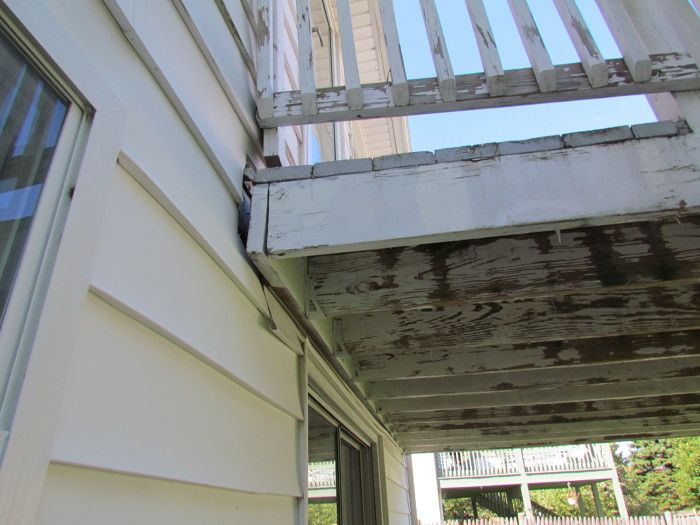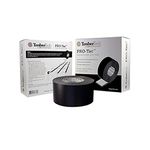Deck Building Don’ts
These 11 major deck-building sins are more common than you might think.

People tend to think of decks as simple projects that don’t require much skill or oversight. Judging from the number of deck collapses I read about and the number of unsafe decks I’ve seen, people are wrong. Below is a short list of things not to do. There are many others, but these are my personal pet peeves.
- Don’t skip the permit. Yeah, the deck is at the back of the house, and you probably won’t get caught. But permits don’t cost much, they help to ensure that the deck is built safely, and you will get caught eventually. That might only happen when you sell the house, but who needs that entirely avoidable headache at an otherwise stressful time?
- Don’t skip the bolts. The most common cause of deck collapses is probably unbolted or inadequately bolted ledgers. This connection has to transfer thousands of pounds of load to the house. Nails alone don’t do it. Use 1/2-in. lag bolts, either hot-dipped galvanized or stainless steel, and long enough to poke through the back side of the band joist, or use proprietary structural screws. Observe the fastening schedule in the code or as provided by the fastener manufacturer.
- Don’t skip the flashing. The second-most common cause of deck collapses is probably when the builder doesn’t flash the house wall to keep water from getting behind the ledger. While the pressure-treated ledger isn’t likely to rot, the house framing isn’t so lucky. No matter how well you’ve bolted the ledger, when the material you’ve bolted it to rots, that deck is coming down.
- Don’t skip the hardware. I’ve seen several recent deck collapses that happened when the joists detached from the ledger because no joist hangers were used. Really? Joist hangers have been around as long as decks have. How is it possible that anyone isn’t using them?
- Don’t attach to a cantilever. Every so often I see a deck collapse because its ledger was attached to the band joist of a cantilevered floor. No amount of bolting or flashing will prevent a collapse in this case. The entire load of the ledger is placed on the nails holding that band joist to the end grain of the house joists. If you have a cantilever, either build a freestanding deck or run the deck joists through the cantilever so they bear on the house wall or foundation.
- Don’t attach to masonry veneer. Masonry veneer is siding, not a structural assembly. It is not intended to support a load. Using long lags to attach to the framing behind the brick isn’t a work-around either, because the bending force imposed on the bolts is too great. Build a freestanding deck instead.
- Don’t skip the end-cut preservative. Sometimes I think I’m the only person who’s ever heard of this stuff (I use Wolman Copper-Coat), but the code specifically requires its use on end cuts. Pressure treatment doesn’t always reach the center of a board, and cutting can expose untreated wood to decay organisms.
- Don’t use 2x10s for stair stringers. When notching a dimensional lumber stringer, code requires leaving at least 5 in. of lumber below the deepest point of the notch. That doesn’t happen when you notch 2×10 stringers for a stair with a code-compliant rise and run. Even so, many of the notched stringers sold in home centers are made from 2x10s. Don’t use them. Use solid stringers, or notch 2x12s. When using notched stringers, support them on posts and footings at least every 6 ft.
- Don’t add a hot tub without proper design. What’s better than relaxing in a hot tub with a cold beer? Not much, except also knowing that the tub isn’t going to fall through the deck. Hot tubs impose a point load that’s measurable in tons. Never add one to a deck that hasn’t been specifically designed for the load.
- Don’t put dissimilar metals in contact with each other. If you use galvanized hardware, fasten it with galvanized nails or structural screws. If you use stainless-steel hardware, fasten it with stainless-steel nails or structural screws. I’ve heard of one case where stainless-steel nails were used with galvanized joist hangers. The nails were fine. The hangers rusted out around them within a couple of years.
- Don’t install decking without spacing it. Tight joints between deck boards trap debris and water. That can start rot in the joists, particularly west of the Rockies where the Douglas fir or hemlock dimensional lumber used outdoors doesn’t take pressure treatment as well as the southern pine used in the East.
Fine Homebuilding Recommended Products
Fine Homebuilding receives a commission for items purchased through links on this site, including Amazon Associates and other affiliate advertising programs.

Flashing and Joist Tape

4-Gallon Piston Backpack Sprayer

Jigsaw






View Comments
I tore off a huge 2nd story deck a couple of years ago. It was connected to a 4' cantilever. The ledger was nailed every 12" with 16d common galvanized nails. It was very hard to get them out. The inner rim joist of the cantilever was nailed to the end grain of the joists and the outer rim joist was nailed to that. It was all still very tight (old growth Doug fir framing) but still made my hair stand up when I saw no bolts or anything to ensure that the deck would remain attached. (Well, it would have stood up if I had any.)
Since I was replacing the deck, I still had to attach it to the cantilever. I added very strong inner angle brackets (Simpson something-or-other) between the inner rim joist and the floor joists to take the vertical load, and I used tension ties (Simpson HD3B or something like that, I don't remember) with bolts through both rim joists and the ledger to keep it from pulling out. I then bolted all three together with a 1/2" bolt every 12" (my joist spacing was 12"o/c) with double bolts at the ends of the ledgers. (It was 26' long so there was a butt joint in the middle.)
That made a very strong assembly to which I then gave a little additional support on each end to ground. I think it was 2x8 framing, so the three together would never make a real "beam" just being supported on each end, but that wasn't really required. It just fitted in with the rest of the project.
I and the engineer are very confident in this connection. I just wish the original builder had read your article.
I'm glad you had an engineer in on this. It sounds like the two of you found a workable solution. Another part of the problem I didn't mention is that in most cases, even if the band is well connected to the house, the cantilever itself isn't designed for the extra load of the deck.
Engineers are darned handy folks to have around.
There are decks ... and then there are DECKS.
Every time I see a deck discussed, the discussion focuses on the connection of the deck to the house. Every discussion also assumes that the deck is a substantial height above ground. Pictures typically show an open area under the deck.
Really? How much of these discussions is relevant to, say, your typical ranch home, built over a crawl space. Here, the deck is only a few steps above grade, and folks often enclose the sides.
After all, why connect a low deck to the house at all? Let it be free-standing; it's a snap to place the decking so that there is only a small gap between the decking and the house.
Left out of the various deck discussions is any mention of the materials to be used. Not all lumber is the same, not even all 'treated' lumber! Your local home center NEVER carries the proper grades of lumber; small wonder so many decks bounce like trampolines.
Here's an idea for a FHB article: build the same deck twice. Do it once using proper materials, and once using every money-saving trick and 'home center' lumber. Then, show us the costs! Just how much are you really 'saving?'
Andy, thanks for the checklist of 'don't skip on...' here. I agree with renosteinke's assertion about building a deck independent of the house structure. This is how I'll build my front deck (porch). Granted, I won't have to worry about flashing, drilling into the band joists or anything, but by code I'll have to the posts about 8' below grade at the posts closest to the house, which I presume is a tad shallower than the base of the house on undisturbed soil. I can't recall right now, but does this particular requirement extend to all posts or only the ones closest to the house. I'm in IN and the frost depth for my county is 3', but I usually go 4' for peace of mind. Sure it uses more concrete for the 8' posts, but as with renosteinke's idea, the gap between the deck and house isn't really noticeable and if nothing else, can be covered with siding or some sort of treated or stained flange between the house and deck.
I'm also glad you mentioned the perils of dissimilar metals. Electrochemical corrosion will ensue parts will eventually fail. Spend the time and money to do things right the first time around.
-Derrick
I'm building a deck 15ft long and 6ft wide. I was going to run the floor joist (2X6) across the width (6') and run the decking (2x6) long length wise (15') is this not a good idea?
Should I run the floor joist lengthwise (15ft)and the decking width wise (6ft)?
Thanks!
Derrick, free standing decks can be a great solution, and the DCA6 provides bracing details for them. One downside to them is that they require more bracing than a deck attached to a house. In many cases, most maybe, I still think that attaching to the house is simpler, faster, and cheaper.
Your outer posts only need to go below frost depth, not the full 8 feet. In fact, the IRC doesn't require frost footings for some free-standing structures such as decks and sheds below a certain size. That said, it does require building on undisturbed earth (or engineered, compacted fill), so that doesn't get you out of digging deep at the house. And it's probably not great to have part of the deck supported on frost footings and the other part not...
It also could depend on the overdig for your foundation. If it's only say, 2 ft., then you could probably put shallow footings 3 ft. from the house and cantilever the rest. But you'd have to know that for sure. And I'm being hypothetical here.
WarsawMan, joists almost always run the short dimension of a structure. Check the DCA6 for deck joist span tables.
reinostencke, I'm not at all sure about home centers never carrying the same grades of lumber. In fact, I'm sure I wouldn't make that statement.
Informative post!! You really shared such a helpful post. I am planning to build a deck in my house and looking for some tips and ideas for how to all these things accomplished. Thanks for such a timely post!
That blog post was fantastic. I'll very certainly return to your blog. Well done!
Fibre Cement Siding